
Verwoerd Ceramics Online
|
|
|
The Compact Guide To Delft Jewelry Signatures Signatures and factory marks are generally very helpful when collecting
ceramics. On Delft jewelry, however, they are often quite difficult to
interpret. If there is a signature, it may simply say 'Delfts' or
'Delfts Holland'. Any addition can be considered a bonus. The reason is
that Delft medallions or 'Delft stones' are in most cases an
intermediate product. The Delft stones are sold to a silversmith, who
produces the silver jewelry, mounts the stones, and
sells the finished product under his own brand name. This is especially
true for the specialist manufacturers of Delft
stones, such as Verwoerd, Van Katwijk, and Olthuysen. Larger Dutch
potteries, where decorators commonly signed with a factory mark and
their personal initials, often continued this practice when producing
Delft medallions. If you're confused by now, because there seems to be
more than one Delft factory, read this first.
|
||||
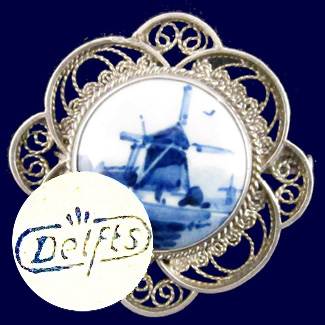 |
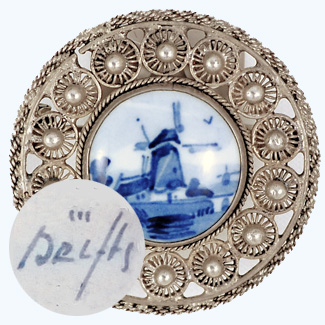
|
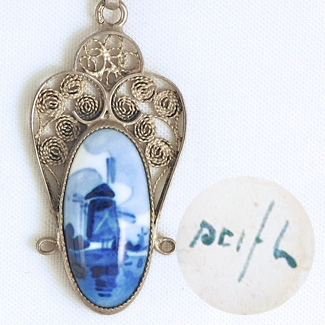
|
||
|---|---|---|---|---|
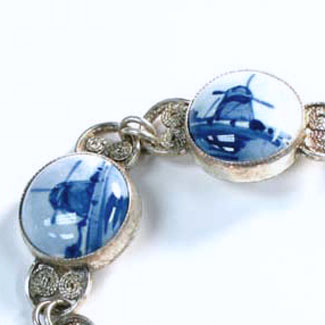
|
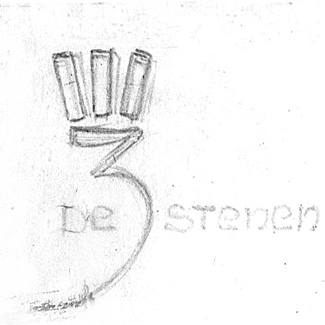
|
|||
|
The Verwoerd Ceramics Studio, of Gouda, Netherlands (1949-1976) starts out using a rubber stamp featuring a cartouche with the word 'Delfts' crowned with three small stripes. This is the factory mark known as the 'Three Stones' signature. It has been used in the years 1949-1950. The illustrations in the top row show a hand painted Verwoerd 'Three Stones' signature from c.1950-1954, and a plain signature from c.1954-1960. Although an early plain Verwoerd 'Delfts' signature may have clearly legible separate letters, later specimens are more difficult to decipher. In this sample the letters t and s have merged into a single scrawl. Verwoerd medallions after 1960 may have no signature at all. The bracelet in the bottom row features well balanced but simple and unmarked windmill landscapes that took less production time. Finally we present an early pencil drawing by Cornelis Verwoerd of a factory mark that as such never has been used, but that reveals the origin of the 'Three Stones' signature. For further information on the Verwoerd Ceramics Studio click here. For further details about the production of Delft medallions click here. (Bracelet picture courtesy 'Hartville Coin & Jewelry'.) |
||||
 |

|

|
||
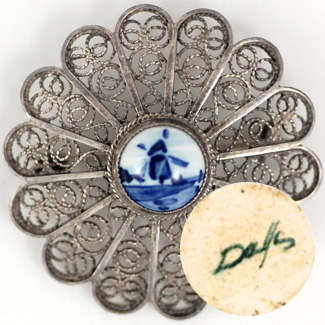
|
P.
Woerlee H.C. de Jong A.G. de Kruyf Ms A.J. Gaasenbeek for Verwoerd Ceramics |
|||
|
Verwoerd Ceramics has produced Delft stones painted by Cornelis Verwoerd personally - see our first entry above - or by one of their hired decorators. Pieter Woerlee, who paints for Verwoerd in 1953-1956, uses the two different Delfts signatures illustrated in the picture on the left. One signature is in capitals - probably the oldest - and the other one is in script. Woerlee never uses his initials on Verwoerd medallions - he did with Van Katwijk - nor did any of the other decorators. The top row shows a sample of the work of H.C. de Jong who is active for Verwoerd in 1949-1956. He initially uses the cartouche stamp. His hand painted 'Three Stones' radiate more widely than on a Verwoerd sample. Next is a brooch by A.G. de Kruyf from 1955-1956. A giveaway is that his small windmill impression at the horizon faces the center of the painting, as the top insert shows. The bottom row has a sample of the work of Ms A.J. Gaasenbeek, who was an apprentice in 1954-1955. Click here for more details about these decorators. |
||||
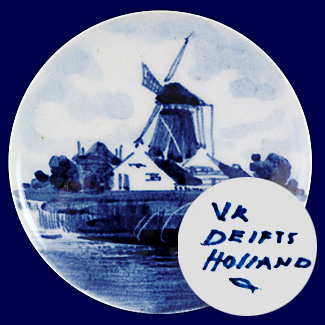 |
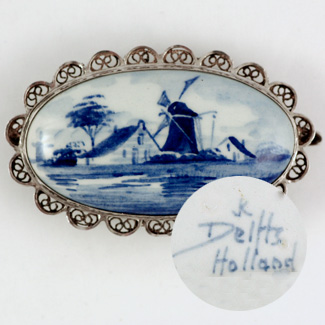
|
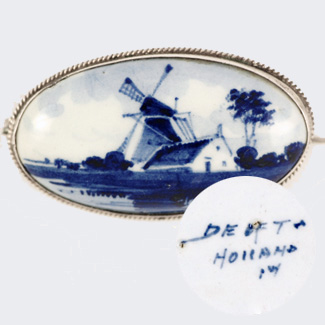
|
||
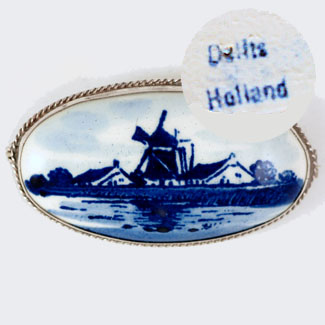
|
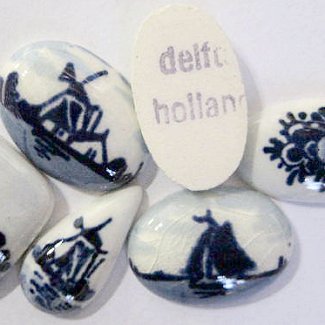
|
|||
|
The Van Katwijk Studio (Gouda 1946-1999) is founded by Frans van Katwijk at the age of 53, after a very successful career with Plateelbakkerij Schoonhoven. The new company is the first to specialize in Delft jewelry inserts, but it produces other ceramics as well. Unfortunately Van Katwijk falls ill, and departs this life as early as November 1952. The workshop continues, but the decorating quality eventually suffers from his absence. In 1958 hand painting largely ends, and screen printing is introduced. The output of the Van Katwijk workshop can therefore be divided in three time periods. Period I, 1946-1953: hand painted, mostly during Frans van Katwijk's lifetime; signed 'Delfts Holland' with occasionally a decorator's mark. Period II, 1953-1958: still hand painted, but of varying quality; all decorators are supposed to use the factory mark VK. Period III, 1958-1999: screen printed cabochons; the VK mark has been skipped, and there is a 'delfts holland' stamp on the reverse. The picture on the left is period II, and as such shows remarkable good painting. It has the VK factory mark. The decorator's mark in de form of a little fish is for Gerrit Suur who worked for the Van Katwijk workshop in 1954-1956. In the top row we present two period I items. The first brooch is signed vK. The letters v and K are connected, but it is not known whether this indicates that it has been painted by Frans van Katwijk personally, or that it represents an early version of the VK factory mark. The second brooch is signed PW and is by freelancer Piet Woerlee. Please note that there are many samples that simply read Delfts Holland, without either VK or a decorator's mark. The first picture in the bottom row is a period III screen printed brooch marked with a 'Delfts Holland' stamp. The screen print is washed in with different shades of blue, so as to imitate hand painting. The final picture shows later period III mass produced screen prints, stamped 'delfts holland'. |
||||
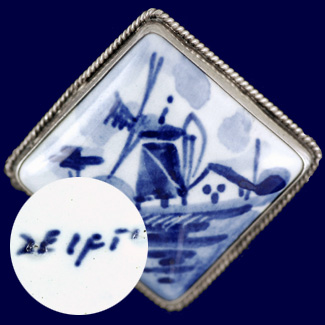 |
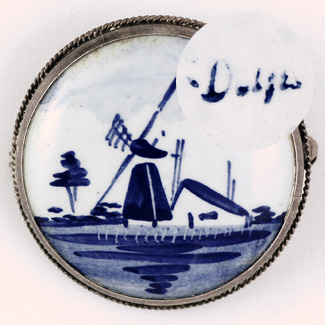
|
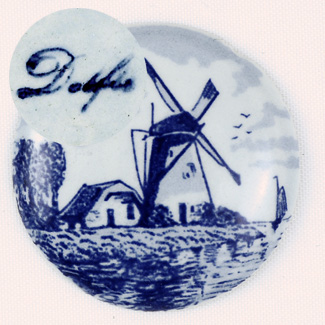
|
||
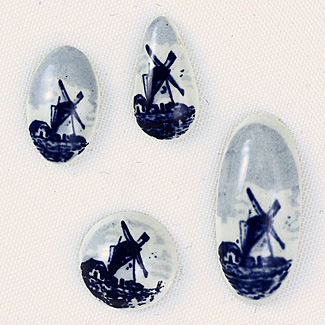
|
Porceletti Gouda, Netherlands c.1952-2001 |
|||
|
'Kunstatelier Porceletti' (the Porceletti Art Studio) was founded by Dick Olthuysen in Gouda in around 1952. They can be viewed as 'The Last of the Specialists'. However, their hand painted Delft was never considered on a par with either Verwoerd or the early Van Katwijk. This may have been one of the factors behind the commercially successful move to transfer printing in the 1960's. The picture on the left shows a hand painted lozenge shaped brooch and its hand painted Delfts mark. The signature in itself is not very distinctive, and should always be considered in combination with the Porceletti naive decorating style. The top row shows an early 1960's hand painted brooch with a printed script Delfts mark, and a later transfer printed cabochon with a slightly different script Delfts mark. As illustrated in the bottom row, the transfer printed windmill design comes in many different sizes and shapes, often without trees or sailing boat. Porceletti continued producing transfer printed cabochons until 2001 when the company was sold. For a crash course on recognizing printed Delft panels click here. |
||||
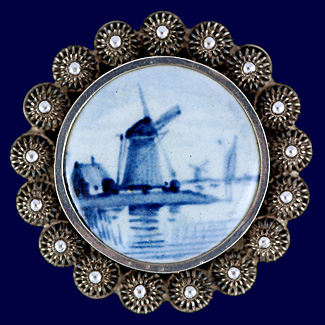 |
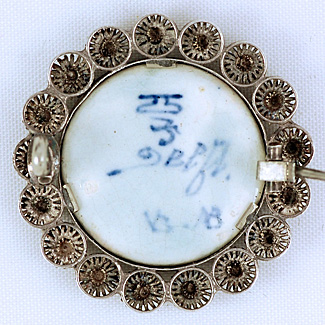
|
|||
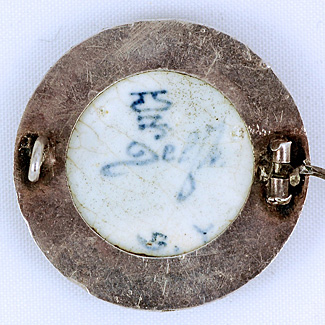
|
De
Porceleyne Fles Delft, Netherlands 1653-present |
|||
|
'De Porceleyne Fles' (aka Royal Delft) was already engaged into Delft jewelry even before Verwoerd, Van Katwijk, and Olthuysen were born. According to Rick Erickson's "Royal Delft - A Guide to De Porceleyne Fles" brocheplaatjes (brooch panels) feature in an inventory list as early as 1879. PF seem to have sold silver mounted as well as unmounted brooch panels. All brooch panels have the well known factory mark that was introduced in around the same time, and that consists of a small jar drawing, the J T monogram, and the word 'Delft'. The windmill brooch presented here has the year mark AB for 1906. We also show a panel with year mark Y for 1903. Both have the decorator's mark VB for W.A. van Baarsel. Year marking starts with A in 1879. Z is 1904, AA is 1905, and AZ is 1930. After that you can simply add 25 years each for BZ (1955), CZ (1980) and so on because the combinations BQ, CQ, and DQ were conveniently skipped. |
||||
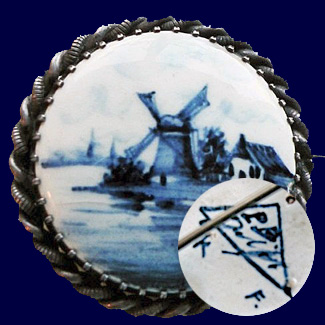 |
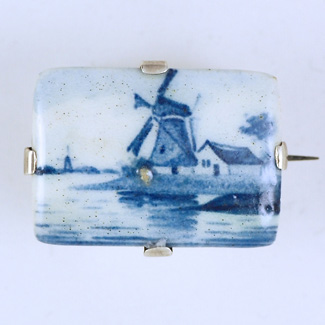
|
|||
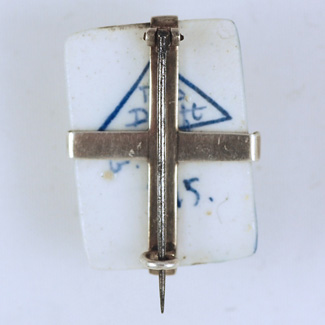
|
Plateelbakkkerij
Delft Amsterdam/Hilversum, Netherlands 1897-1928 (1967) |
|||
|
The lead of the Porceleyne Fles is followed by Plateelbakkerij Delft (PBD), probably after 1902 when decorator - and future owner - Nicolaas Oosterhoff makes the switchover from the Porceleyne Fles to PBD. The 'Fles' habit of using year letters starts in Hilversum with A in 1903. The illustration on the left shows a PBD sample with year letter F for 1908. Decorator K is unknown. The other illustrations show a rectangular Delft panel in a somewhat unusual, crude setting that partly conceals the back of the brooch. Even so, the factory mark can easily be recognized. PBD closed its doors in 1928, and was reborn as Hilversumse Plateelbakkerij (1928-1967). (Round brooch picture courtesy 'Makeityour'.) |
||||
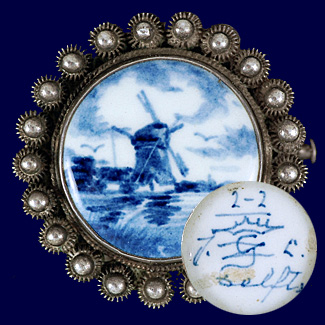 |
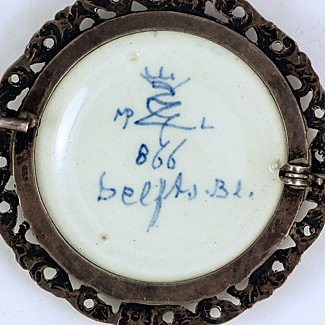
|
|||
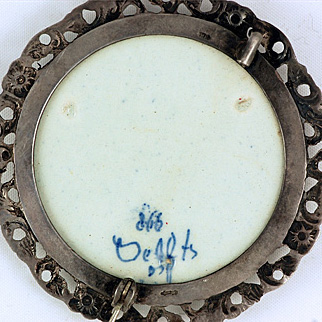
|
Zenith Gouda, Netherlands 1749-1984 |
|||
|
Plateelbakkerij en Pijpenfabrieken 'Zenith' had excellent contacts with Schoonhoven silversmiths, and was probably the first of the Gouda potteries to add Delft brooch panels to their product line in around 1939. The picture on the left shows a 1939 brooch marked with the crowned ZG monogram for 'Zenith Gouda' and the word 'Delfts'. The model number is 2-2, and L is for Landscape. Decorator J is unknown. The next picture shows a model 866 brooch panel. It has the crowned ZG monogram, the model number 866, and the text 'Delfts Bl.' (Delfts Blauw in full). MP is for decorator Maarten Peek. The model number 866 safely identifies the brooch in the lower picture as by Zenith, even if there is no ZG factory mark. Decorator DJ is H.C. de Jong. Model 866 is a 4,8cm panel designed in 1939 for a cast frame by silversmith H. Hooykaas. Is has been used during the 1940's, and perhaps the early 1950's. Please note that the Hooykaas frame has also been produced in a silver plated variety marked 90, which is the equivalent of a thin silver layer of about 12µ. If you want the solid silver version, look for the little sword hallmark. For more information on Dutch and Schoonhoven silver marks click here. |
||||
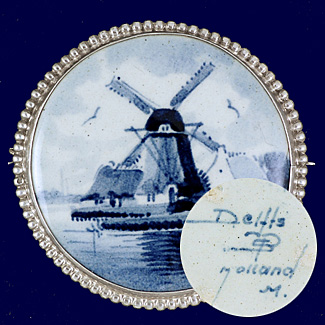 |
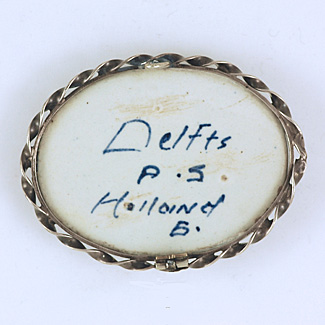
|
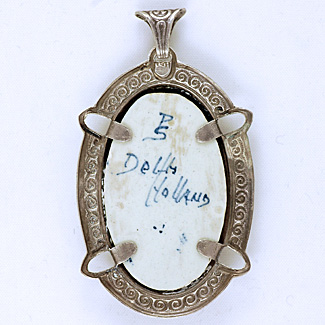
|
||
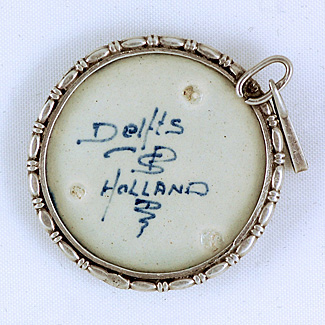
|
Plateelbakkerij
Schoonhoven Schoonhoven, Netherlands 1920-present |
|||
|
'Plateelbakkerij Schoonhoven' (Est. 1920 - presently Schoonhoven Keramiek) started their important production of Delft jewelry inserts probably during the early 1940's. The brooch on the left is after WW2, and is marked with a monogram of an intertwined P and S for Plateelbakkerij Schoonhoven and the text 'Delfts Holland'. Decorator M is unknown. The top row shows a late 1940's brooch marked with P.S. and decorator's mark B, possibly for Jo van den Bergh. 'Delfts' has an oversized capital D typical of this decorator. The three small dots on the reverse of the pendant represent a decorator's mark as well. The owner is not known, so we have dubbed him 'the master of the three dots'. The pendant in the bottom row is between 1944 and 1953. It has the PS monogram and an ornamented D for a decorator's mark. Once more the owner is unknown. We would love to continue our inquiries, but a serious problem is that the Schoonhoven Keramiek archives are currently not open for research. The decorator's marks are nevertheless important, because they may help identifying a Delft insert as Schoonhoven, even if the PS monogram is missing. |
||||
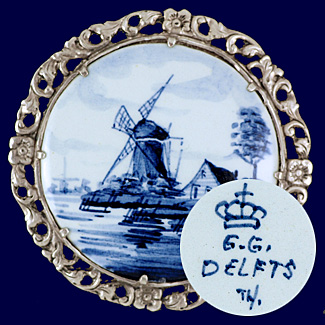 |
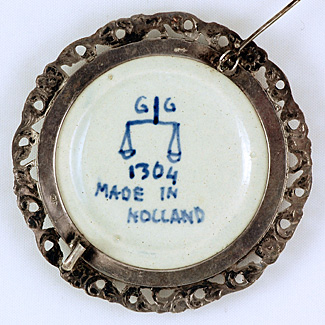
|
|||
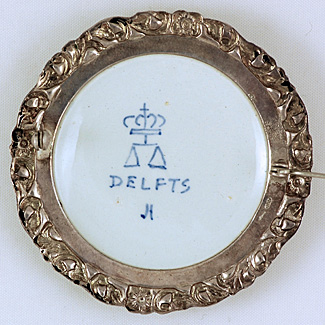
|
Goedewaagen Gouda/Nieuw Buinen, Netherlands 1779 (1612)-present |
|||
|
Goedewaagen - present trade name 'Royal Goedewaagen' - was established in 1779. In 1853 they acquired the Gouda pottery 'De Star' which goes back to 1612. Goedewaagen has produced 4,8cm Delft brooch panels for silversmith H. Hooykaas of Schoonhoven during the 1950's and perhaps the early 60's. Please note that the Hooykaas frame exists in both a silver and a silver plated version (see our remark in the Zenith entry above). The factory mark on the reverse of the pottery panels is either GG for Goedewaagen Gouda, or the Goedewaagen Scales mark, or both. Decorator JH is J. Hooijmeijer, and the decorator's mark TH can perhaps be attributed to Tonny den Hartog. The brooch that has the model number 1364 is the oldest of the three samples, c.1950. |
||||
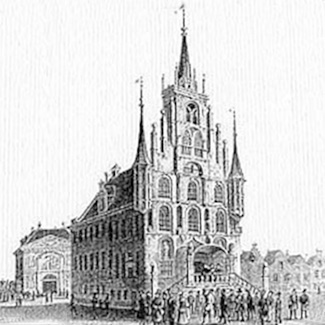 |
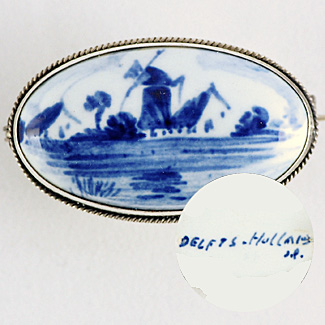
|
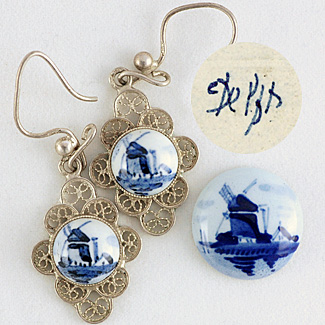
|
||
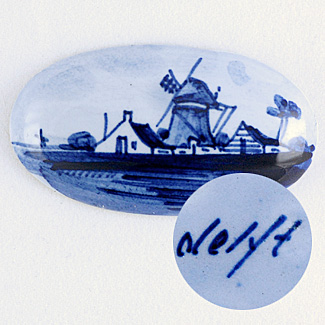
|
Quo
Vadis Tertoolen Nuvelsteijn of Gouda, Netherlands |
|||
|
In this entry we present three lesser known Gouda manufacturers of Delft brooch panels. Nevertheless, some of their larger medallions can easily be recognized. The first picture in the top row is a Delft brooch by the Quo Vadis pottery (1938-1969) owned by Th.J.J. Rouwen. They are supposed to have produced thousands of Delft inserts during the 1950's. The style is semi-naive, and the reverse is marked 'Delfts-Holland'. The decorator's mark JB can possibly be attributed to Jan Bijlaart. We have seen a somewhat similar brooch marked B, and another sample marked K. The Quo Vadis pottery was bought by Goedewaagen in 1969. Next is a small collection by L.W.A. Tertoolen (1922-2003). Reportedly Tertoolen owned a small firm "Bureau Ceramique" shortly after WW2. However, the Delft stones shown here have been made around 1970 in the workshop of a friend. We didn't find any official records. The designs are easily recognized from their square windmill bodies, and the distinctive 'Delfts' signature. The bottom row shows a sample by J. Nuvelsteijn who owned a pottery in Gouda until the 1960's. The style is a form of ligne clair, but the stones primarily leap out because front and back are covered in a transparant blueish glaze. The signature is 'delft' rather than 'delfts', and has a lower case 'd'. (Gouda town hall picture free of rights.) |
||||
|
Help us help you |
||||
| Thank you for visiting our site! | ||||